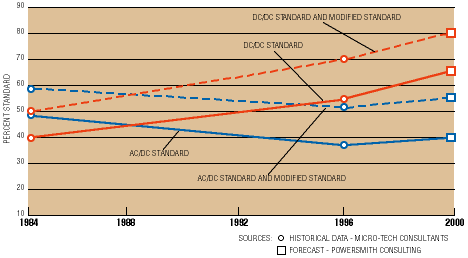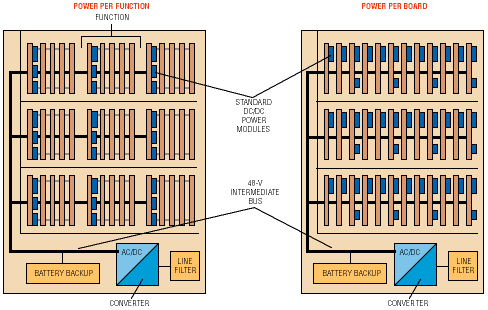Standard dc/dc modules
displace custom supplies
Design, qualification, and cost benefits steer
more designers to standard power system components
BY LARS THORSELL
Ericsson Components
Richardson, TX
Today's power systems increasingly use a number of standard dc/dc modules linked to an ac/dc front end in place of a custom ac/dc supply. The trend toward using standard and modified standard dc/dc power modules will be even more pronounced in the future as designers increasingly seek to speed product design and lower total power system development and production costs.
Today's standard dc/dc modules are available in ratings from 5 to 500 W, though most modules in use are in the 5 to 50-W range. In addition to dc/dc modules that convert an intermediate dc voltage (usually 48 or 24 Vdc) to 3.3, 5, or ±12 Vdc, several manufacturers have begun to offer standard ac/dc units that convert the ac line to 24 or 48 Vdc. This makes it easier for the system designer to implement a complete power system using standard modules.
Over the past decade, standard power modules have improved significantly in efficiency, reliability, product availability, functionality, ease of use, thermal design, and cost.Figure 1 shows the growth of standard modules, as well as modified standard modules, which incorporate minor changes to pinout, interface signals, or voltages to meet specific user requirements.

Fig. 1. Standard and modified standard dc/dc modules continue to grow in usage
as designers seek alternatives to costly custom power supplies.
Both standard and modified standard modules deliver electrical performance equal to or better than custom ac/dc supplies.
Power conversion modules originated in the telecom industry, where telecom applications are often configured in a pluggable card-on-board package. The cards draw power from the central office battery system, nominally 48 or 60 Vdc (see Fig. 2 ). Packaging the power conversion function on the circuit card allows it to be easily added or removed from the system as circuit-function needs change.

Fig. 2. In a 48-V bus telecom power system, standard dc/dc modules reside on pluggable
cards that can be added or removed as circuit function needs change.
There are eight advantages to standard dc/dc modules:.
1. Faster time to market. Developing a custom power supply can take anywhere from 6 to 18 months. Often several months go by in the equipment design schedule before the power requirements are known with enough certainty to begin power supply development. Designing a custom power supply involves at least one design iteration due either to changing system requirements or power supply design and qualification problems.
By contrast, standard dc/dc modules allow power supply prototypes that are identical to the production units to be delivered within days. Standard modules eliminate repeated design iterations because their reliability, manufacturability, and ability to pass qualification testing have already been proven.
2. Latest technology. Standard dc/dc modules offer the latest technology in terms of circuit packaging, integration, automated manufacturing, and high efficiency. By contrast, custom power supply designs often can only use older technology because of the pressure to complete the design as quickly as possible. Also, the manufacturing volumes of custom supplies are often too small to justify the use of advanced topologies, packaging techniques, and automated manufacturing processes common to standard converter modules.
3. Easier thermal design. Thermal design problems often plague custom power supply development. The uncertain temperature and airflow environment in the end equipment, coupled with the concentration of all the power conversion dissipation in one area of the equipment, usually dictates installing a special cooling fan or blower for the supply.
Standard power modules are typically distributed throughout the system and can be cooled with the existing airflow used for the load circuitry. In addition, the modules are extensively characterized by their manufacturer so that the power dissipation, cooling paths, and thermal resistance are well defined. When needed, standard heat sinks are also available to lower module case temperatures and enhance reliability.
4. System availability. The modular nature of standard dc/dc converters allows them be to used in power systems requiring power to be available at all times. N + 1-redundant configurations are well suited for these standard modules, which are small, lightweight, and designed to be placed at the point of load. In addition, since the power modules operate from a 24- or 48-V input, designers can easily implement techniques such as battery backup.
5. Suited for distributed systems. The small size and modular nature of standard converters also suits them for distributed-power architectures. That's because additional converters can easily be added as a power system's power capability and functional needs grow. A large selection of standard dc/dc modules is now available, and modular standard ac/dc front-end modules are starting to become available.
6. Product qualification. Custom power supplies often create a problem with qualification testing of the end system. This can occur either during internal testing or during agency approval testing. EMC-related problems are particularly common. By contrast, standard modules have UL/CSA-type approvals and have a history of being used in equipment that has successfully passed EMC testing. The module simplifies the end-equipment approval and reduces associated time delays.
7. Dual sourcing. Standard dc/dc modules have dual or multiple sourcing, accomplished either by pin compatibility and similar functionality from different vendors or by cross-licensing between vendors. Either approach eliminates the non-recurring expenses associated with dual development of a custom power supply.
8. Lower total cost of ownership (TCO). Equipment designers are now using a TCO model to understand their true system costs. A power system's TCO includes hardware acquisition cost, development cost, time-to-market cost, and reliability cost. Recent price reductions in standard power modules have resulted in the TCO of a distributed system using standard modules being roughly the same as a custom power supply with a centralized architecture.
Advertisement





